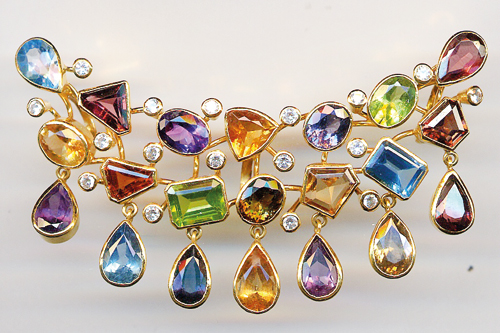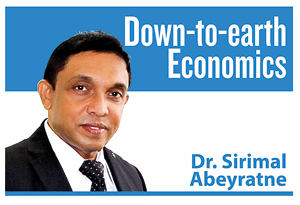Complexities of gold trade
View(s):
File picture of gold jewellery.
Last week a friend of mine had forwarded a picture of a receipt issued by a Sri Lankan jewellery shop in 1975. I was confused initially but fascinated by the information on the receipt. Its description in Sinhala reads as “one-pound coin” and the price as “Rs.15.00”. First, I thought that it was a sovereign gold coin sold for Rs.15.00, but gold prices were much higher than that even in 1975. While the international price of a sovereign gold coin was about US$40 at that time, its Sri Lankan price would have been roughly about Rs.280. Then I realised that it was a currency coin – a British Sterling pound, which was Rs.15.50 in 1975.
Someone must have sold a sterling pound coin to the jewelry shop for Rs.15. If you consider that the profit must have been just 50 cents for the shop when the exchange rate of the pound was Rs.15.50, then, actually you are wrong. It was not the case during that time.
Having faced with a severe foreign exchange shortage, the country had adopted stringent foreign exchange controls so that even a single sterling pound coin was important. Anyway, the jewellery shop has to import gold so that foreign exchange was necessary to continue with the business. Besides that, the exchange rate of sterling pound quoted here was just the “official rate” whereas there was a “black market” for foreign exchange where the dealers make big profits illegally.
Forty-five years later
It is absolutely shocking to see how the price of gold as well as the exchange rates have changed over time. You would see that the exchange rate of British sterling pound has increased from Rs. 15.50 in 1975 to Rs. 235.00 in 2020; it is a more than 15-times increase. Similarly, during the same period the exchange rate of the US dollar has increased from Rs.7 to Rs. 190; it is a more than 27-times increase.
On the other hand, the local price of a sovereign gold coin has increased from Rs. 290 to over Rs. 80,000; it is a more than 275-times increase! Unlike the exchange rate issue, the gold price issue has the impact of its international price movement as well. Today, the top-most important gold trading centres in the world are located in the UK, the US, and China, while the other important gold markets which are all in Asia include Dubai, India, Japan, Singapore and Hong Kong. Over the past forty-five years, international gold prices have increased in the UK’s London gold market in terms of the British sterling pound, from about £20 to £320; it is a 16-times increase. In terms of US dollars in the US’ New York gold market the gold prices have increased from about $150 to $1740; it is nearly 12-times increase. The differences in price change between London and New York gold markets, reflect again the differences in the UK pound and US dollar exchange rate, and not the different price movements between the two markets.
When there is a price difference between different markets – London and New York, we should also know that such differences do not last long. Investors in commodity markets such as gold markets, are quick enough to move their investment funds between markets taking the advantage of arbitrage – the very act itself create demand-supply adjustments which would quickly remove the price differences between the markets.
Gold as an investment
Gold together with other semi-precious metals such as silver was one of the oldest currencies in the world which served as a medium of exchange as well as a medium of wealth. European and American financiers whose business was to undertake and protect others’ gold deposits issuing “gold receipts” gave birth to the modern banking system and to the paper note currencies.
In 1913, the US established the Federal Reserve Bank (FED) to formalise and stabilise “dollar-gold relationship” in the country. The stocks of gold backed the value of the currency notes issued by the central banks until 1944. After that the US dollar was backed by the stock of gold in the US, while currencies of other countries were pegged to the US dollar until 1971. After 1971, the US abandoned the dollar-gold relationship, but continued to maintain gold as part of the assets.
Today, gold is an alternative asset for investment such as other assets like company stocks or government or corporate bonds. About 40 per cent of the world demand for gold emanates from investment demand, while 50 per cent of gold demand is for jewellery and the balance 10 per cent for other manufacturing. Therefore, international gold prices respond to the gold supply and gold mining as well as rising demand from Asia particularly for jewellery. But gold prices are highly volatile too in response to investor sentiments.
 In good times of the world economy, investors put their money into company stocks and bond markets. In bad times, they shift that money into gold markets. Thus, bad times become worse as stock markets collapse, but gold prices begin to rise due to higher investment demand. For this reason, international gold prices are high today! The world is faced with an economic recession caused by COVID-19 so that some investments such as those in stock and bond markets are losing the value. As investments have moved into gold markets, gold prices are on the rise. Once the recession is over and the world economy begins to recover such investment would move back to stock and bond markets causing a decline in demand for gold investment.
In good times of the world economy, investors put their money into company stocks and bond markets. In bad times, they shift that money into gold markets. Thus, bad times become worse as stock markets collapse, but gold prices begin to rise due to higher investment demand. For this reason, international gold prices are high today! The world is faced with an economic recession caused by COVID-19 so that some investments such as those in stock and bond markets are losing the value. As investments have moved into gold markets, gold prices are on the rise. Once the recession is over and the world economy begins to recover such investment would move back to stock and bond markets causing a decline in demand for gold investment.
Sri Lanka’s story
Sri Lanka has a different story to tell. Even though the country has unique resources and outstanding talents with authentic historical roots to flourish a “world-class” jewelry industry together with a booming gold-trading post in the region, the country has probably missed the bus. The industry had the government push, even during the time of the controlled economy whereas the move did not lead to a developed jewellery industry but limited to exporting just the precious stones.
During the recent past the rush for gold is an interesting story. While India has increased its tariffs on gold imports, Sri Lanka’s imports of gold increased unusually – about 8,000 kg in 2016 and in 2017. It has added to the country’s mounting trade deficit, especially because there was no matching increase in exports of jewellery. What the authorities believed was that, gold has been imported to Sri Lanka in order to smuggle into other countries.
What should be the usual reaction now? An easy way out of the problem is imposing higher taxes on gold imports. Sri Lanka did that in April 2018 by levying a 15 per cent tax on imports of gold. As a result, imports under the sector Diamonds, Precious Stones and Metals, where gold imports are recorded, declined from $772 million in 2017 to $201 million in 2019.
The question
I have a question: If gold is smuggled by importing via Sri Lanka, then it is a problem of the lack of an efficient surveillance mechanism, prevalence of corruption, and a weak regulatory framework. We would have addressed these issues rather using the easy way out with higher import duties. However, by imposing the duties again we have closed the door to another potential export industry and to open an international gold market in Sri Lanka.
Had the policies being designed in the past focused on such long-term developments in the country, the other issue – pressure on the exchange rate would have been reversed too. In the face of COVID -19 today, we are faced with even more pressure on maintaining exchange rate stability than it was in the past. In the absence of increased foreign exchange earnings, we are at the mercy of our bilateral and multilateral lenders for maintaining the exchange rate and meeting our foreign debt obligations. Governments have come and gone from time to time and in the process bringing the nation from bad to worse at every turn.
(The writer is a Professor of Economics at the University of Colombo and can be reached at sirimal@econ.cmb.ac.lk).



